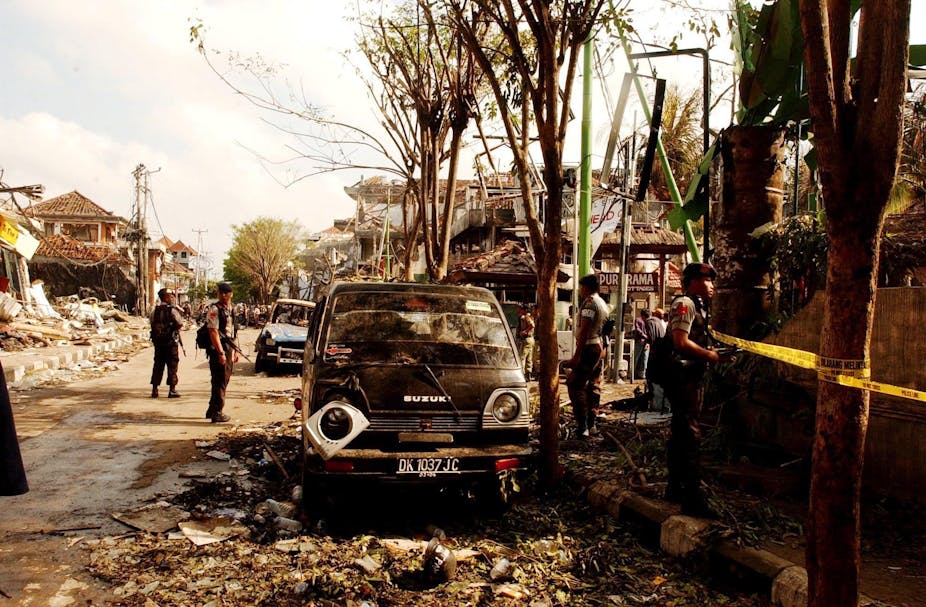Ten years ago, the Bali bombings unleashed a torrent of grief. Alongside the dreadful toll of dead and injured, Australians mourned the loss of Bali as a holiday idyll. Journalists turned to the image of “Paradise Lost” to express this loss. Politicians spoke of the bombings as the moment when Australia lost its innocence.
The strong emotions spoke to the attachment Australians had to Bali. By the 1990s, Bali had become our favourite holiday destination. According to the Australian Bureau of Statistics, almost 350,000 travelled to Indonesia in 1998 – more than the number heading to the traditional “kinship” destinations of Britain and the United States. The Australian presence was most palpable in Kuta. Hotels and restaurants offered Vegemite with their toast, and bars with names like the “Bali-Aussie” or “Koala Blu” broadcast footy games live. The Balinese kids who hung out at Kuta Beach spoke English with an Australian accent, and even peddlers selling cheap t-shirts on the streets called you ‘mate’.
Australians felt more comfortable in Bali than they had ever felt in Asia before. The history of Australian-Asian relations is marked with anxiety. Many Australians felt uneasy about their nation’s place as a European outpost, and much of our history is marked by fears regarding our proximity to Asia. But, in some small way, Bali began to change that.
By the 1990s, Australian tourists were referring to Bali as “a home away from home”. Some even began to wonder if Bali wasn’t on its way to becoming an unofficial state of Australia. At the precipice of the Asian Century, we are starting to hear that the tyranny of distance from Europe has been replaced by the advantage of proximity to Asia. This advantage was first understood by the millions of Australians who lay back on their deckchairs, Bintang in hand, only a few short hours after leaving an overcast Sydney, Melbourne or Perth behind.
This sense of connection amplified the shock of the Bali bombings. Media coverage casually presented Bali as an extension of Australia in reports of terrorism at “home”, on “our doorstep” or at “our backdoor”. The emotion coloured the political response to the bombings. The belief that the Bali bombings had struck “home” was used to bolster support for Australia’s involvement in the War on Terror. Politicians from both major parties claimed that the bombings revealed that Australia did not have the option of remaining neutral.
The attacks also changed the way many Australians thought about Bali, and Asia more generally. The carefree atmosphere vanished after the first bombs exploded in the Bounty and the Sari Club. It was further shattered in 2005, when a second round of bombings targeted the quiet, family-friendly seafood restaurants that line Jimbaran Bay. Anxiety again began to characterise Australian perceptions of their region, which was now referred to as the “arc of instability”. Rather than evoking memories of innocent holidays, braided hair and cheap shopping, Bali – along with Indonesia and much of Southeast Asia – began to attract strongly-worded travel advisories warning Australians to stay away.
And stay away they did. The number of Australians heading to Indonesia plummeted after both the 2002 and 2005 bombings. The falls were so dramatic that economists worried that the tourism industry, and the Balinese economy as a whole, may not recover. But in the longer term, Australians did return. Arrivals figures set new records from 2008, only three years after the second terrorist attacks. Last year, nearly 900,000 Australians nominated Indonesia as their primary destination on airport departure cards. Based on current trends, the number will reach one million this year. That’s nearly one in twenty Australians visiting Indonesia, in one year alone.
There are many reasons for our return. Some tourists wanted to help the Balinese after the post-bombings economic downturn; others spoke of a determination to show terrorists that they will not be cowed. But the main reason why Australians have returned to Bali is both more mundane and more profound: Australians feel at ease there. Bali is beautiful, it’s close and it’s cheap. Even the terror of the bombings could not replace the sense that Bali was a place where Australians could relax. Years of holiday experiences had a more powerful effect on Australian perceptions of Asia than a demonstrable record of crises.
Ten years after the attacks, Bali is again Australia’s “home away from home”. The anniversary allows us to take stock of the bombings’ long-term effects. It also allows us to think about how our travels shape our ideas about the world, and what role “ordinary” Australians should play in international affairs.
The continued delay in releasing the government’s “Australia in the Asian Century” white paper, now months overdue, suggests that uncertainty about Australian-Asian relations reigns at the highest levels.
Navel-gazing about Australia’s place in the region continues to sell newspapers and books. But, while politicians and journalists prevaricate, ‘ordinary’ Australians have been voting with their feet. Our return to Bali says more about Australia’s place in Asia than the forced bonhomie of diplomatic meetings or self-interested negotiations at economic roundtables.
‘Ordinary’ Australians are often refreshingly unselfconscious about their engagement with Asia. Many prefer to rely on their own knowledge of the region, built up over decades of travel experiences, rather than the shrill rhetoric and alarmist images occasionally broadcast by some politicians, and some elements in the media.
Travel and personal contact have helped convince us that Australia is part of the Asian region, and that this is not a bad thing.
The enthusiasm of our return to “Paradise Lost” suggests that we feel increasingly comfortable within our region as we enter the Asian Century.

